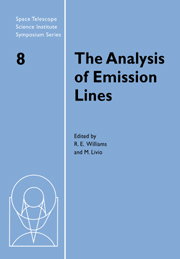Book contents
- Frontmatter
- Contents
- Participants
- Preface
- Emission Lines: Past and Future
- Atomic Data for the Analysis of Emission Lines
- Radiative Transfer
- Emission Lines from Winds
- Photoionizing Shocks
- The Lexington Benchmarks for Numerical Simulations of Nebulae
- Emission Line Diagnostics
- Ultraviolet Spectroscopy
- Infrared Emission Lines as Probes of Gaseous Nebulae
- Molecular Emission Line Diagnostics in Astrophysical Environments
- Abundance Determinations
- Astrophysical Gamma Ray Emission Lines
- Summary Remarks
Photoionizing Shocks
Published online by Cambridge University Press: 23 November 2009
- Frontmatter
- Contents
- Participants
- Preface
- Emission Lines: Past and Future
- Atomic Data for the Analysis of Emission Lines
- Radiative Transfer
- Emission Lines from Winds
- Photoionizing Shocks
- The Lexington Benchmarks for Numerical Simulations of Nebulae
- Emission Line Diagnostics
- Ultraviolet Spectroscopy
- Infrared Emission Lines as Probes of Gaseous Nebulae
- Molecular Emission Line Diagnostics in Astrophysical Environments
- Abundance Determinations
- Astrophysical Gamma Ray Emission Lines
- Summary Remarks
Summary
A high velocity radiative shock, or one moving into high-metallicity gas provides an efficient means to generate a strong UV photon field. If there is gas available in the pre- or post-shock zones to absorb this, then the optical emission from the shock and precursor region can be dominated by photoionisation, rather than by cooling and the optical + UV emission scales as the mechanical energy flux through the shock. The diagnostic characteristics of such shocks are discussed for the cases of supernova remnants, NLRs, LINERs and cooling flows.
Introduction
Let me preface this paper to say how honoured I am to have been given this opportunity to pay tribute simultaneously to two of the principal sources of scientific inspiration of my career. In my attempts over the past twenty years to understand and to analyse the optical and UV spectra of shock-excited plasmas, Don's books (1974, 1988) have been invaluable to both myself and to my students. In Australia we used to refer to the Physics of Gaseous Nebulae somewhat irreverently as “the new testament” to distinguish it from the earlier work by Aller! The famous diagnostic diagrams of Baldwin, Phillips & Terlevich (1981), of Veilleux & Osterbrock (1987), and of Osterbrock, Tran & Veilleux (1992) provide both an inspiration, and a powerful means of distinguishing between various excitation mechanisms.
- Type
- Chapter
- Information
- The Analysis of Emission Lines , pp. 65 - 82Publisher: Cambridge University PressPrint publication year: 1995
- 4
- Cited by



